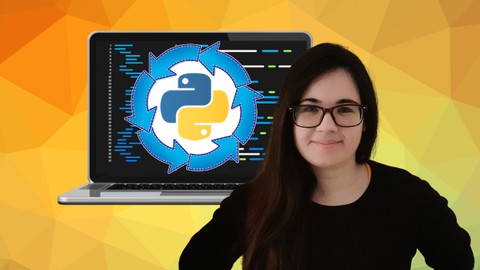
Python Loops and Looping Techniques: Beginner to Advanced
Python Loops and Looping Techniques: Beginner to Advanced, available at $74.99, has an average rating of 4.73, with 218 lectures, 81 quizzes, based on 293 reviews, and has 2067 subscribers.
You will learn about Understand the differences between for loops and while loops in Python. Choose the right type of loop and looping technique for a given scenario. Write for loops and while loops that are efficient and easy to read. Use for loops to iterate over strings, lists, tuples, dictionaries, sets, and file objects. Use built-in functions such as range(), enumerate(), zip(), sorted(), and reversed() to write for loops. Understand the purpose of the break and continue statements and how they control the flow of execution of a loop. Understand and write nested for loops and nested while loops. Identify and fix infinite loops in Python. This course is ideal for individuals who are Beginners who want to learn how to use loops in Python and how they work behind the scenes. or Students who are taking a Python course for school or work. or Professionals who want to learn how to use loops and looping techniques efficiently in their work. or Anyone who is interested in learning more about Python programming. It is particularly useful for Beginners who want to learn how to use loops in Python and how they work behind the scenes. or Students who are taking a Python course for school or work. or Professionals who want to learn how to use loops and looping techniques efficiently in their work. or Anyone who is interested in learning more about Python programming.
Enroll now: Python Loops and Looping Techniques: Beginner to Advanced
Summary
Title: Python Loops and Looping Techniques: Beginner to Advanced
Price: $74.99
Average Rating: 4.73
Number of Lectures: 218
Number of Quizzes: 81
Number of Published Lectures: 218
Number of Published Quizzes: 81
Number of Curriculum Items: 303
Number of Published Curriculum Objects: 303
Number of Practice Tests: 1
Number of Published Practice Tests: 1
Original Price: $39.99
Quality Status: approved
Status: Live
What You Will Learn
- Understand the differences between for loops and while loops in Python.
- Choose the right type of loop and looping technique for a given scenario.
- Write for loops and while loops that are efficient and easy to read.
- Use for loops to iterate over strings, lists, tuples, dictionaries, sets, and file objects.
- Use built-in functions such as range(), enumerate(), zip(), sorted(), and reversed() to write for loops.
- Understand the purpose of the break and continue statements and how they control the flow of execution of a loop.
- Understand and write nested for loops and nested while loops.
- Identify and fix infinite loops in Python.
Who Should Attend
- Beginners who want to learn how to use loops in Python and how they work behind the scenes.
- Students who are taking a Python course for school or work.
- Professionals who want to learn how to use loops and looping techniques efficiently in their work.
- Anyone who is interested in learning more about Python programming.
Target Audiences
- Beginners who want to learn how to use loops in Python and how they work behind the scenes.
- Students who are taking a Python course for school or work.
- Professionals who want to learn how to use loops and looping techniques efficiently in their work.
- Anyone who is interested in learning more about Python programming.
Learn how to use the power of for Loops, while Loops, nested loops (and more!) in Python. Build 4 projects, understand how loops work behind the scenes, and practice with coding exercises.
Take your Python skills to the next level by mastering loops and looping techniques.
-
Learn how for Loops and while Loops work behind the scenes with step-by-step graphical explanations.
-
Use the power of built-in Python functions such as range(), enumerate(), zip(), sorted(), and reversed()to make your loops more powerful, more concise and more readable.
-
Understand how nested for loopsand nested while loops work and learn how to use them in practical scenarios.
-
Customize the functionality of your loops with breakand continue. Learn how they work and when to use them.
-
Iterate over strings, lists, tuples, dictionaries, and sets.
-
Detect infinite loops, find their cause, stop them and fix them.
-
Write clearer and more concise Python code.
Student Reviews
– “This course in awesome, it makes me understand the power of loops and how it benefit us in programming.” – Surya Teja.
– “Great course. Most python courses do not cover loops in depth. Having an in depth understanding of loops is quite essential as loops are a crucial aspect of programming.” – Dee.
– “My sincere thanks go out to the instructor. For more than five years I have been trying to learn Python, but I am not satisfied with my learning method. After taking this course, I understood how to learn the programming and execute the code in a beginner’s manner. I would recommend this course not only for professionals, but even for school kids who want to learn how Python syntax and code work together to build a program. Ultimately, I found a course that suited my learning style and helped me understand the concept. In a simplified manner, she will help you clear up any doubts you may have.” – Durga.
– “I love this course, the instructor has a way to make these serious materials feels fresh and fun.”- Ivan Juniardi.
Course Updates
August 2023 – UPDATE!Section 21 now has intermediate and advanced coding exercises.
May 2023 –NEW!Updated video lectures with a renewed style and a new code editor (Visual Studio Code).
May 2023 –NEW!Updated section overview videos
May 2023 –NEW!Updated lecture and section names
May 2023 –NEW!Improved assignments
May 2023 –NEW!Discussion topics for each section
May 2023 –NEW!Redesigned first and last sections
May 2023 –NEW!Improved and expanded quizzes
April 2023 – NEW! Updated articles with new format.
Nov 2021 –NEW!Updated quizzes with detailed explanations for each answer.
Oct 2021 –NEW!Downloadable Python files for the course exercises.
Enhance your resume with new Python skills.
Python is a very popular programming language that is used for a variety of real-world applications, including web development, data science, machine learning, and artificial intelligence. Learning Python loops and looping techniques is a great way to advance your skills in computer science. Loops are essential tools for any programmer, and they can be used to write powerful and efficient programs.
You will definitely use loops in any field, including:
-
Web Development
-
Machine Learning
-
Data Science
-
Artificial Intelligence
-
Game Development
-
Mobile App Development
-
Bioinformatics
-
Medical Software
-
Computer Vision
-
and… many more.
Loops are also essential to implement data structures and algorithms. If you are thinking about entering any of these fields or if you are planning to expand your computer science skills, then this course is for you.
Any piece of software that you can possibly imagine has repetitive processes that are implemented using loops. The concepts and techniques that you will learn in this course are easily transferable to other programming languages like Java, JavaScript, and many more.
Goals
By the end of this course, you will be able to:
-
Work with for loops and while loops in your programs.
-
Understand how they work.
-
Read loops written by other developers and understand their purpose.
-
Write nested loops and determine when to use them to approach tasks.
-
Use the break and continue statements to stop loops when certain conditions are met.
-
Use built-in Python functions in your for loops to write cleaner code, remove unnecessary variables, and make your code more concise.
Projects
You will work on 4 projects:
-
Draw a Pattern:you will use Python’s built-in turtle module to draw patterns using for loops. We will start by drawing simple patterns and then gradually increase their complexity. You will be able to customize this project and experiment with the principles of for loops.
-
Caesar Cipher: you will implement this basic encryption algorithm using a for loop. When the project is completed, you will be able to encrypt and decrypt secret messages (like Julius Caesar did!).
-
Guess the Number: you will use a while loop and the binary search algorithm to implement a text-based guessing game. The user will select a number between 1 and 100, and the computer will try to guess the number by repeatedly halving the range of possible numbers. The binary search algorithm is explained in detail during the course.
-
Analyze Book Passages: you will use nested loops to read and analyze the content of a book passage in a text file. The program will display the frequency of each letter and the letter with the maximum frequency.
As you can see, you will have many opportunities to apply your knowledge in a wide range of areas during the course.
You will also acquire additional skills such as: problem solving, computational thinking, file handling in Python, knowledge of the Binary Search algorithm and the turtle module. All while learning how to work with loops!
Learning Material & Resources
Throughout the course, you will find these resources:
-
Video Lectures: 10+ hours of video lectures with carefully designed graphics, tables, and code visualizations. You will see how the code works behind the scenes with step-by-step explanations.
-
Projects:build 4 projects and apply your skills in practical scenarios.
-
Coding Exercises: practice with 40+ interactive coding exercises with their corresponding solutions. You will be able to check your solution immediately with the automated grader.
-
Quizzes: check your knowledge with 30+ quizzes with 120+ questions that provide unlimited attempts and instant feedback.
-
Course Exam: take a final exam to test your knowledge of everything you learned during the course. The exam consists of 25+ questions and you can take it as many times as you like. You will receive detailed results for each attempt, so you can track your progress and identify areas where you need to improve.
-
Study Guide: review for the course exam with a detailed study guide with 100+ questions.
-
Articles: read 80+ articles with detailed explanations and illustrations.
What makes this course unique?
This course is unique in its focus on providing visual and detailed explanations of how each type of loop works in Python. You will not only learn how to use loops, but you will also understand the purpose of each line of code. This will give you a deeper understanding of how loops work and how they can be used to solve problems.
The course comes with a variety of study materials that complement the course experience. These resources include a study guide specifically designed for the course, which includes over 100 questions on the course content.
You will be able to solve coding exercises directly on the browser and you will receive instant feedback for your submission.
You will check your knowledge with quizzes that provide instant feedback and questions that will make you think more deeply about the topics presented in each section.
You will receive a certificate of completion that you can add to your resume and social media profiles to showcase your new skills.
You will also have lifetime access to the course.
You are very welcome to watch the preview lectures and check out the full course curriculum.
If you are looking for an engaging, visual, and practical course, then you found it.
Enroll now, add “Python Loops and Looping Techniques” to your resume, and showcase your new skills.
Course Curriculum
Chapter 1: Welcome to the Course: Python Loops and Looping Techniques
Lecture 1: Welcome to the Course – Course Overview
Lecture 2: Welcome to the Course – Important Course Information
Lecture 3: Introduce Yourself and Share your Goals
Chapter 2: Iterables in Python: Strings, Lists, Tuples, Dictionaries, and Sets
Lecture 1: Welcome to this Section – Iterables in Python
Lecture 2: About this Section
Lecture 3: What is an Iterable?
Lecture 4: Common Terminology: Element vs. Item
Lecture 5: Quick Review: Boolean Operators and Functions
Lecture 6: Strings in Python
Lecture 7: String Slicing in Python
Lecture 8: String Methods in Python
Lecture 9: Using the Interactive Shell
Lecture 10: Coding Session: Strings
Lecture 11: String Concatenations in Python
Lecture 12: Lists in Python
Lecture 13: List Slicing in Python
Lecture 14: Coding Session: Lists
Lecture 15: List Methods in Python
Lecture 16: Nested Lists in Python
Lecture 17: Tuples in Python
Lecture 18: Lists vs. Tuples in Python
Lecture 19: Coding Session: Tuples
Lecture 20: Nested Tuples in Python
Lecture 21: Dictionaries in Python
Lecture 22: Dictionary Methods in Python
Lecture 23: Coding Session: Dictionaries
Lecture 24: Nested Dictionaries in Python
Lecture 25: Sets in Python
Lecture 26: Coding Session: Sets
Lecture 27: Set vs. Frozenset
Lecture 28: Sets – Recommended Reading
Lecture 29: Discussion Topic: Share your Thoughts
Chapter 3: for Loops in Python
Lecture 1: Welcome to this Section – for Loops in Python
Lecture 2: What is a Loop?
Lecture 3: Iteration in Python Loops
Lecture 4: for Loops in Python: Purpose and Use Cases
Lecture 5: for Loops Behind the Scenes
Lecture 6: How to Write for Loops in Python (Syntax)
Lecture 7: Coding Session: Write your First for Loop
Lecture 8: Indentation in Python – Suggested by PEP 8
Lecture 9: The Loop Variable in for Loops
Lecture 10: Discussion Topic: Share your Thoughts
Chapter 4: for Loops and range()
Lecture 1: Welcome to this Section – for Loops in range()
Lecture 2: range() in Python
Lecture 3: Purpose and Advantages of range()
Lecture 4: Print the Sequence Returned by range() as a List
Lecture 5: Coding Session: range() With One Parameter (Basic Examples)
Lecture 6: Coding Session: range() With One Parameter (Intermediate Examples)
Lecture 7: Coding Session: range() With One Parameter (More Advanced Examples)
Lecture 8: Coding Session: Checking if a String is a Palindrome
Lecture 9: range() With Two Parameters in Python
Lecture 10: Coding Session: range() With Two Parameters (Basic Examples)
Lecture 11: Coding Session: range() With Two Parameters (Intermediate Examples)
Lecture 12: Coding Session: range() With Two Parameters (More Advanced Examples)
Lecture 13: range() With Three Parameters in Python
Lecture 14: Coding Session: range() With Three Parameters (start, stop, step)
Lecture 15: Coding Session: range() With Three Parameters (Intermediate)
Lecture 16: Default Values of start, stop, and step
Lecture 17: range() With Negative Parameters in Python
Lecture 18: Examples of range() with Negative Arguments
Lecture 19: Comparing range() Objects with == and !=
Lecture 20: Python Documentation of range()
Lecture 21: Discussion Topic: Share your Thoughts
Chapter 5: Practical Section: For Loops and the range() Function
Lecture 1: Discussion Topic: Share your Thoughts
Chapter 6: Project: Draw Patterns with for Loops and range()
Lecture 1: Welcome to this Project – Draw Patterns Using for Loops and range()
Lecture 2: The turtle Module in Python
Lecture 3: Coordinates and Angles in the turtle Module
Lecture 4: How to Move the Turtle (Pen)
Lecture 5: Basic Shapes: Square and Circle
Lecture 6: Intermediate Pattern: Black and White Spiral
Instructors
-
Estefania Cassingena Navone
Software Developer, Instructor and Technical Writer
Rating Distribution
- 1 stars: 3 votes
- 2 stars: 5 votes
- 3 stars: 16 votes
- 4 stars: 67 votes
- 5 stars: 202 votes
Frequently Asked Questions
How long do I have access to the course materials?
You can view and review the lecture materials indefinitely, like an on-demand channel.
Can I take my courses with me wherever I go?
Definitely! If you have an internet connection, courses on Udemy are available on any device at any time. If you don’t have an internet connection, some instructors also let their students download course lectures. That’s up to the instructor though, so make sure you get on their good side!
You may also like
- Best Cybersecurity Fundamentals Courses to Learn in March 2025
- Best Smart Home Technology Courses to Learn in March 2025
- Best Holistic Health Courses to Learn in March 2025
- Best Nutrition And Diet Planning Courses to Learn in March 2025
- Best Yoga Instruction Courses to Learn in March 2025
- Best Stress Management Courses to Learn in March 2025
- Best Mindfulness Meditation Courses to Learn in March 2025
- Best Life Coaching Courses to Learn in March 2025
- Best Career Development Courses to Learn in March 2025
- Best Relationship Building Courses to Learn in March 2025
- Best Parenting Skills Courses to Learn in March 2025
- Best Home Improvement Courses to Learn in March 2025
- Best Gardening Courses to Learn in March 2025
- Best Sewing And Knitting Courses to Learn in March 2025
- Best Interior Design Courses to Learn in March 2025
- Best Writing Courses Courses to Learn in March 2025
- Best Storytelling Courses to Learn in March 2025
- Best Creativity Workshops Courses to Learn in March 2025
- Best Resilience Training Courses to Learn in March 2025
- Best Emotional Intelligence Courses to Learn in March 2025






















